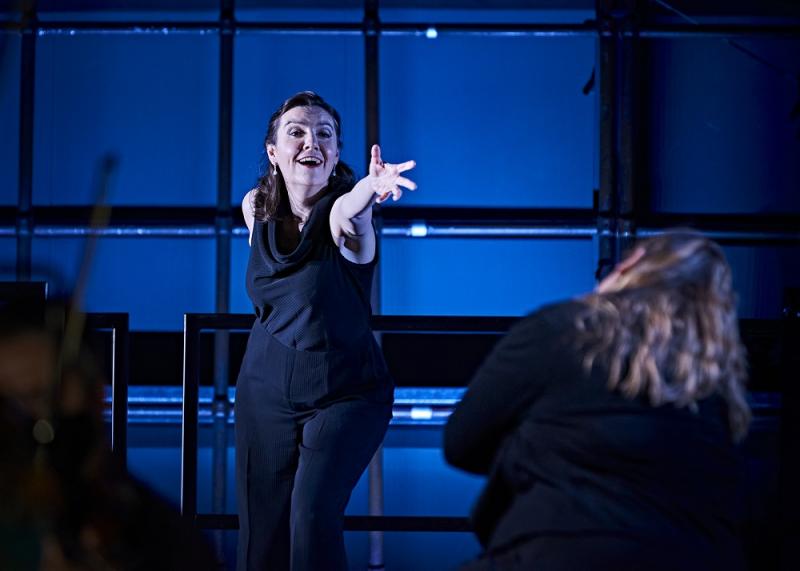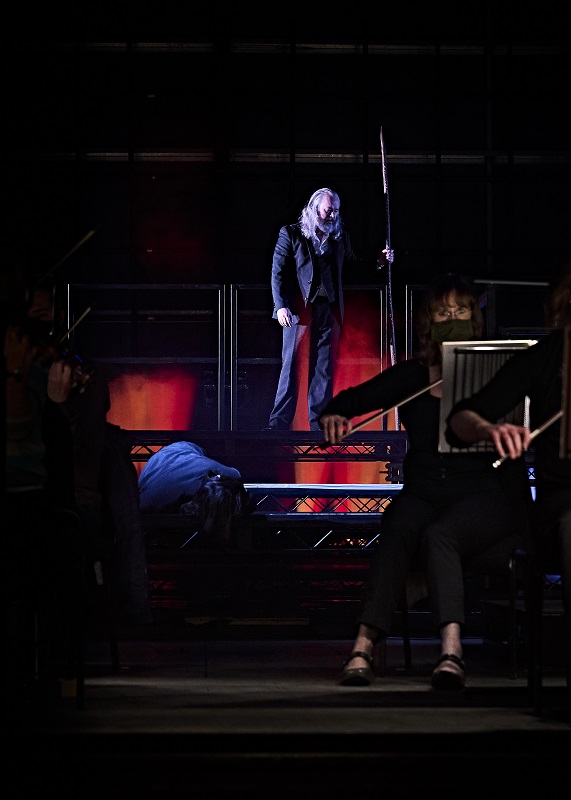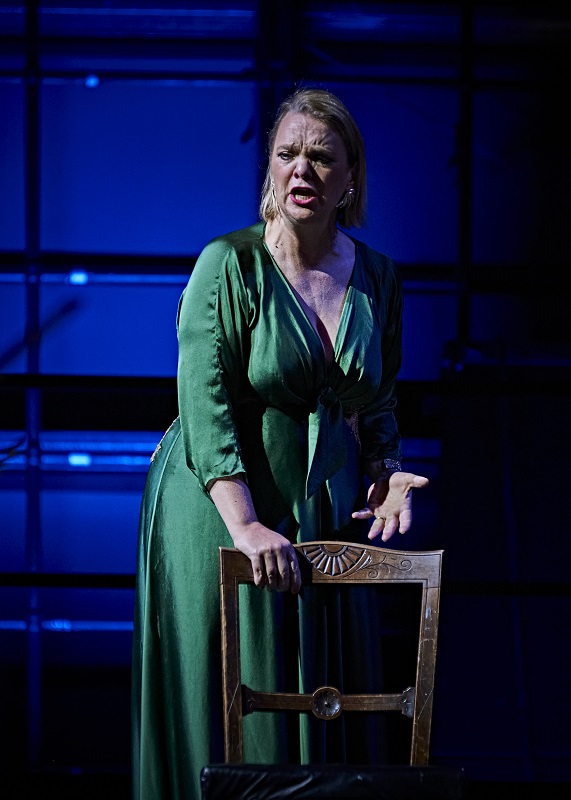Die Walküre, Longborough Festival Opera review - heroic defiance of farcical constraints | reviews, news & interviews
Die Walküre, Longborough Festival Opera review - heroic defiance of farcical constraints
Die Walküre, Longborough Festival Opera review - heroic defiance of farcical constraints
Wagner cut down to size refuses to shrink

Whatever might be said about Longborough Festival’s first live opera since 2019, the first and most important thing is to praise the company without reservation for putting on a show of anything like this quality in the face of obstacles of the sort that normally confront the heroes of Russian fairy tales.
So: no kissing, embracing or even approaching within two metres in an opera that begins with twins falling passionately, violently in love, and ends with Wotan literally kissing away Brünnhilde’s immortality (pictuted below, Paul Carey Jones at the end of the opera). So: general distancing that enforces a reduction of Wagner’s orchestra by more than two thirds with the string section on the stage, thereby also reducing the available acting space to a series of narrow upstage catwalks and a thin strip at the footlights. So: string players masked but singers and (presumably) wind players not, hence I daresay spreading clouds of deadly viruses all over the rest of us. At the best of times Wagner can be a conductor’s and director’s nightmare. Under the Covid Soviet it verges on farce.
 I suspect that Amy Lane would want to stand by this semi-staging of Die Walküre not as an example of her best professional work, but as a tribute to her ability to put a worthwhile show together at all under such absurd conditions. Just think. There being no space in front of the orchestra for any significant action, most of it had to happen behind it, with predictable consequences for vocal-orchestral balance. But the catwalks had to be raised, so that we could see them, which meant the movement of characters was entirely linear, like cars going through one of those chicanes on the old East German border. Now and then a character would disappear, and reappear mysteriously at the footlights. My friend Barry Millington, who knows everything there is to know about Wagner, thought this indicated the humanising of, first, Brünnhilde then, later, Wotan. But maybe it was simply getting too crowded on the catwalks.
I suspect that Amy Lane would want to stand by this semi-staging of Die Walküre not as an example of her best professional work, but as a tribute to her ability to put a worthwhile show together at all under such absurd conditions. Just think. There being no space in front of the orchestra for any significant action, most of it had to happen behind it, with predictable consequences for vocal-orchestral balance. But the catwalks had to be raised, so that we could see them, which meant the movement of characters was entirely linear, like cars going through one of those chicanes on the old East German border. Now and then a character would disappear, and reappear mysteriously at the footlights. My friend Barry Millington, who knows everything there is to know about Wagner, thought this indicated the humanising of, first, Brünnhilde then, later, Wotan. But maybe it was simply getting too crowded on the catwalks.
Lane has already staged a mercifully straightforward, concept-free Rheingold at Longborough, and the rest of her Ring will be well worth waiting for. Meanwhile we have this very good, potentially very strong cast, and the always excellent Anthony Negus, giving us a Walküre memorable on musical as well as logistical grounds. The key to the performance is an extraordinary reduction of the score by Francis Griffin, whose re-creation of Wagner’s textures and sonorities is so astonishingly successful that at times one wonders whether Negus hasn’t got another fifty or sixty players tucked away in the far corners of the pit as well as the woodwind and brass players one can clearly hear.
Wagner specifies sixty-four strings, Negus has sixteen; Wagner has quadruple woodwind, Negus has single; Wagner, eight horns (with Wagner tubas), Negus two horns and no Wagner tubas; and so on. The textures are sometimes very simple, but often complicated; yet apart from odd moments, I was only really conscious of a limitation in the intricate final pages, where the two separate themes of Wotan’s lyrical farewell counterpoint with Loge’s fire music. The Ride of the Valkyries, with its spectacular scoring for woodwind and brass, worked a treat. All this tends to confirm Karl Böhm’s suggestion long ago that Wagner could be read as chamber music. This was chamber playing, with quality to match.
 The cast, like the production, sounds better than it looks. After a tepid start Sarah Marie Kramer and Peter Wedd are a fine, emotionally intense pair of lover-twins, while looking more like father and daughter. Perhaps make-up, involving touch, is still against the rules. Paul Carey Jones is a musically rich, dark-sounding Wotan, but a wooden actor, even by catwalk standards, while Brindley Sherratt’s Hunding has great vocal menace but looks like a retired headmaster.
The cast, like the production, sounds better than it looks. After a tepid start Sarah Marie Kramer and Peter Wedd are a fine, emotionally intense pair of lover-twins, while looking more like father and daughter. Perhaps make-up, involving touch, is still against the rules. Paul Carey Jones is a musically rich, dark-sounding Wotan, but a wooden actor, even by catwalk standards, while Brindley Sherratt’s Hunding has great vocal menace but looks like a retired headmaster.
But the stars of the show, for my money, are Madeleine Shaw (pictured left), who completely dominates Fricka’s scene with Wotan - which, of course, she is meant to do, and what a psychologically incomparable scene it is; and Lee Bisset’s lively, attractive Brünnhilde, moving seamlessly from “Hojotoho” Valkyrie to the lost, desperate woman of the final scene as if the latter were already implicit in the former, a deeply touching, convincing portrait. Everyone overacts, with arm-wavings and body-swayings that explode disproportionately out of the catwalk mentality. But this will soon, surely, be no more than a quaint memory.
The future of Arts Journalism
You can stop theartsdesk.com closing!
We urgently need financing to survive. Our fundraising drive has thus far raised £49,000 but we need to reach £100,000 or we will be forced to close. Please contribute here: https://gofund.me/c3f6033d
And if you can forward this information to anyone who might assist, we’d be grateful.

Subscribe to theartsdesk.com
Thank you for continuing to read our work on theartsdesk.com. For unlimited access to every article in its entirety, including our archive of more than 15,000 pieces, we're asking for £5 per month or £40 per year. We feel it's a very good deal, and hope you do too.
To take a subscription now simply click here.
And if you're looking for that extra gift for a friend or family member, why not treat them to a theartsdesk.com gift subscription?
more Opera
 La bohème, Opera North review - still young at 32
Love and separation, ecstasy and heartbreak, in masterfully updated Puccini
La bohème, Opera North review - still young at 32
Love and separation, ecstasy and heartbreak, in masterfully updated Puccini
 Albert Herring, English National Opera review - a great comedy with depths fully realised
Britten’s delight was never made for the Coliseum, but it works on its first outing there
Albert Herring, English National Opera review - a great comedy with depths fully realised
Britten’s delight was never made for the Coliseum, but it works on its first outing there
 Carmen, English National Opera review - not quite dangerous
Hopes for Niamh O’Sullivan only partly fulfilled, though much good singing throughout
Carmen, English National Opera review - not quite dangerous
Hopes for Niamh O’Sullivan only partly fulfilled, though much good singing throughout
 Giustino, Linbury Theatre review - a stylish account of a slight opera
Gods, mortals and monsters do battle in Handel's charming drama
Giustino, Linbury Theatre review - a stylish account of a slight opera
Gods, mortals and monsters do battle in Handel's charming drama
 Susanna, Opera North review - hybrid staging of a Handel oratorio
Dance and signing complement outstanding singing in a story of virtue rewarded
Susanna, Opera North review - hybrid staging of a Handel oratorio
Dance and signing complement outstanding singing in a story of virtue rewarded
 Ariodante, Opéra Garnier, Paris review - a blast of Baroque beauty
A near-perfect night at the opera
Ariodante, Opéra Garnier, Paris review - a blast of Baroque beauty
A near-perfect night at the opera
 Cinderella/La Cenerentola, English National Opera review - the truth behind the tinsel
Appealing performances cut through hyperactive stagecraft
Cinderella/La Cenerentola, English National Opera review - the truth behind the tinsel
Appealing performances cut through hyperactive stagecraft
 Tosca, Royal Opera review - Ailyn Pérez steps in as the most vivid of divas
Jakub Hrůša’s multicoloured Puccini last night found a soprano to match
Tosca, Royal Opera review - Ailyn Pérez steps in as the most vivid of divas
Jakub Hrůša’s multicoloured Puccini last night found a soprano to match
 Tosca, Welsh National Opera review - a great company reduced to brilliance
The old warhorse made special by the basics
Tosca, Welsh National Opera review - a great company reduced to brilliance
The old warhorse made special by the basics
 BBC Proms: The Marriage of Figaro, Glyndebourne Festival review - merriment and menace
Strong Proms transfer for a robust and affecting show
BBC Proms: The Marriage of Figaro, Glyndebourne Festival review - merriment and menace
Strong Proms transfer for a robust and affecting show
 BBC Proms: Suor Angelica, LSO, Pappano review - earthly passion, heavenly grief
A Sister to remember blesses Puccini's convent tragedy
BBC Proms: Suor Angelica, LSO, Pappano review - earthly passion, heavenly grief
A Sister to remember blesses Puccini's convent tragedy
 Orpheus and Eurydice, Opera Queensland/SCO, Edinburgh International Festival 2025 review - dazzling, but distracting
Eye-popping acrobatics don’t always assist in Gluck’s quest for operatic truth
Orpheus and Eurydice, Opera Queensland/SCO, Edinburgh International Festival 2025 review - dazzling, but distracting
Eye-popping acrobatics don’t always assist in Gluck’s quest for operatic truth

Add comment